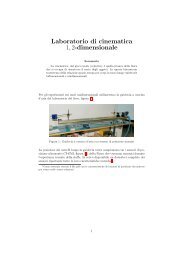Newton's law of cooling revisited - Cartan
Newton's law of cooling revisited - Cartan
Newton's law of cooling revisited - Cartan
You also want an ePaper? Increase the reach of your titles
YUMPU automatically turns print PDFs into web optimized ePapers that Google loves.
1068 M Vollmer<br />
(a)<br />
(c)<br />
(b)<br />
Figure 2. Schematic temperature distributions within solid objects upon <strong>cooling</strong> as a function <strong>of</strong><br />
the increasing Biot number (Bi = 0, Bi = 0(1), i.e. <strong>of</strong> the order <strong>of</strong> unity, Bi ≫ 1). For finite<br />
object temperature, there is an additional temperature drop at the boundary to the surrounding<br />
fluid, which was omitted here. The intermediate situation (b) depicts also the differences between<br />
surface, centre and average temperature <strong>of</strong> a sphere.<br />
Table 1 gives a summary <strong>of</strong> Biot numbers for some objects used in our experiments (see<br />
below). For small objects <strong>of</strong> metal the condition Bi < 0.1 is usually fulfilled. The same holds<br />
for cans/bottles filled with water for both the liquid inside and the walls <strong>of</strong> the container. This<br />
means that we can simplify the models by assuming thermal equilibrium within the objects,<br />
i.e. by describing the <strong>cooling</strong> process with average temperatures <strong>of</strong> the objects. In the case <strong>of</strong><br />
bottles/cans, any internal convection <strong>of</strong> the water would increase λ, hence decrease Bi further.<br />
4. Simplified model for <strong>cooling</strong> <strong>of</strong> objects for Bi ≪ 1<br />
Consider a homogeneously heated object, which can be described by a small Biot number, i.e.<br />
an average temperature is sufficient to characterize the <strong>cooling</strong> <strong>of</strong> the object. If the object is<br />
just placed in air, we assume typical values for heat-transfer coefficients for free convection<br />
(solids to gases) in the range 2–25 W (m 2 K) −1 . Supposing an initial temperature Tinit <strong>of</strong> the<br />
objects, energy conservation requires that any heat loss will lead to a decrease <strong>of</strong> the thermal




